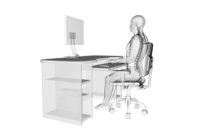Category: Injuries and Illness
Modern safety management goes beyond covering traditional workplace accidents to now being equally concerned with illnesses caused on and even off the job. This section will explain what you need to know to avoid both injuries and illnesses, and to track your progress in reaching this goal.
AIHA (formerly the American Industrial Hygiene Association) launched a new website—https://www.workerhealthsafety.org/first-responders—with occupational health resources about the long-term health risks faced by emergency responders. The website includes a case study of training to prepare first responders for rail emergencies and a directory of industrial hygienists and occupational and environmental health and safety (OEHS) professionals.
Many of us spend hours at our workstations every day, and with many of us working from home because of COVID-19, the ergonomic issues have come home with us. Bad habits and incorrect posture can lead to neck and back pain or sore wrists and fingers. Proper ergonomics can help you and your employees stay […]
The National Institute of Occupational Safety and Health (NIOSH) stressed the importance of collecting, coding, analyzing, and reporting both industry and occupation data in coronavirus disease 2019 (COVID-19) case reports to form better strategies for reducing the impact of the pandemic on workers.
On August 18, the National Safety Council (NSC) predicted that coronavirus disease 2019 (COVID-19) may become the third leading cause of death in the United States for 2020, behind only heart disease and cancer. In 2018, the most recent year of final fatality data, the third leading cause of death was preventable deaths from drug […]
A large number of noise-exposed workers within the services industry sector—the largest sector in U.S. industry—have an elevated risk of hearing loss, according to new research from the National Institute for Occupational Safety and Health (NIOSH). The study of hearing loss in workers across a wide variety of service industries was recently published in the […]
Due to increasing COVID-19 case counts across many states, public health officials are recommending source control measures to reduce disease transmission, including mandatory mask use in public places. Unfortunately, these measures rely upon the user’s effective compliance, both in work and in social settings. Growing evidence suggests that aerosols may play a part in the […]
The rate of nonfatal workplace injuries and illnesses has declined from 10.9 cases per 100 full-time employees in 1972 to 2.8 cases in 2018, the Labor Department’s Bureau of Labor Statistics (BLS) noted in its monthly publication, Beyond the Numbers. The July 2020 issue of the BLS’s publication, “Nearly 50 years of occupational safety and […]
No environment, health, and safety (EHS) professional wants to experience an incident at a job site, but the resulting investigation is an opportunity to uncover safety problems and correct them. You must take the right steps to get the right result, however, and the right result is the prevention of incident recurrence. Here are six […]
The National Institute for Occupational Safety and Health (NIOSH) released its 2020-2029 strategic plan for its Center for Motor Vehicle Safety (CMVS). The plan implements priorities from the institute-wide strategic plan for fiscal years 2019-2023 with input from other sources.
Exceptions from respiratory protection regulations allowing the use of surgical masks only apply to healthcare facilities and emergency medical services, the Occupational Safety and Health Administration (OSHA) reminded employers. Other employers must provide respirators, the agency explained in guidance discussing the differences among cloth face coverings, surgical masks, and respirators.










